window MITSUBISHI COLT 2008 (in English) Service Manual
[x] Cancel search | Manufacturer: MITSUBISHI, Model Year: 2008, Model line: COLT, Model: MITSUBISHI COLT 2008Pages: 450, PDF Size: 14.57 MB
Page 270 of 450

5-54 For pleasant driving
5Error codes
E00710100422
If an error code (1) appears in th
e frequency display window, take actio n in accordance with the table below.
Error codeCauseSolution
LORD No disc inside Insert disc.
CDP E 01
Faulty disc (CD player)
(most likely) Insert several other discs.
If the error code appears only with certain disc(s
), the problem may be due to scratch(es) and/or
dirt on the disc(s). Refrain from using any damaged disc(s).
If the error code appears with all discs, the problem may be due to condensation or dirt inside the
equipment. Wait several hours and try again. If the error code still appears with all discs, please
have the equipment inspected.
CDP E 02
CDC E 01
Faulty disc (CD
changer) (most likely)
CDC E 02
Page 336 of 450
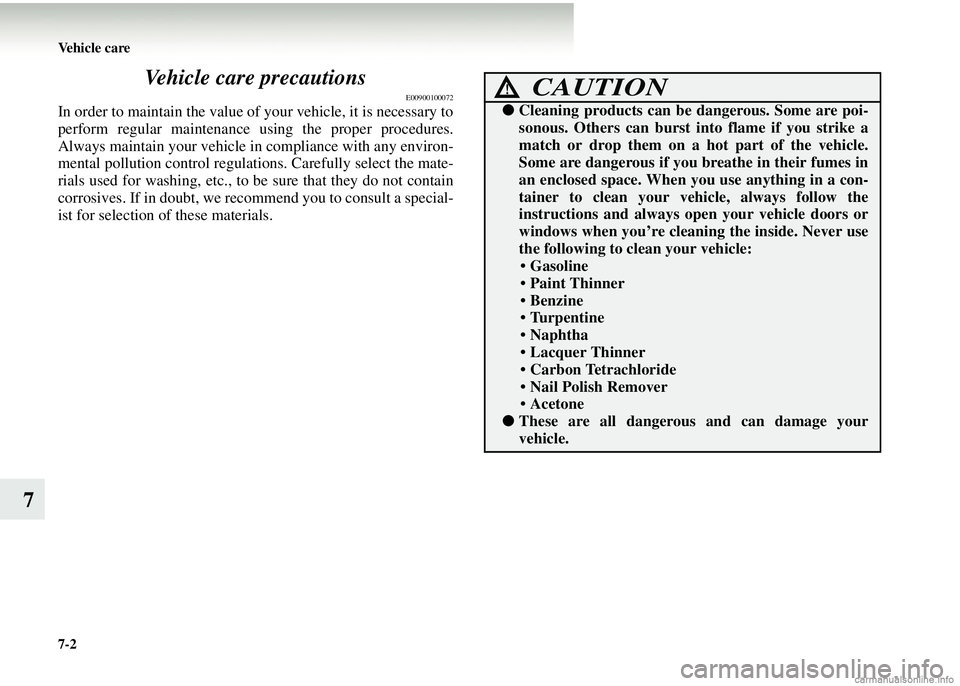
7-2 Vehicle care
7Vehicle care precautions
E00900100072
In order to maintain the value of your vehicle, it is necessary to
perform regular maintenance using the proper procedures.
Always maintain your vehicle
in compliance with any environ-
mental pollution control regulations. Carefully select the mate-
rials used for washing, etc., to be sure that they do not contain
corrosives. If in doubt, we reco mmend you to consult a special-
ist for selection of these materials.
CAUTION!
● Cleaning products can be dangerous. Some are poi-
sonous. Others can burst into flame if you strike a
match or drop them on a hot part of the vehicle.
Some are dangerous if you breathe in their fumes in
an enclosed space. When you use anything in a con-
tainer to clean your vehi cle, always follow the
instructions and always open your vehicle doors or
windows when you’re cleani ng the inside. Never use
the following to clean your vehicle:
• Gasoline
• Paint Thinner
• Benzine
• Turpentine
• Naphtha
• Lacquer Thinner
• Carbon Tetrachloride
• Nail Polish Remover
• Acetone
● These are all dangerous and can damage your
vehicle.
Page 342 of 450
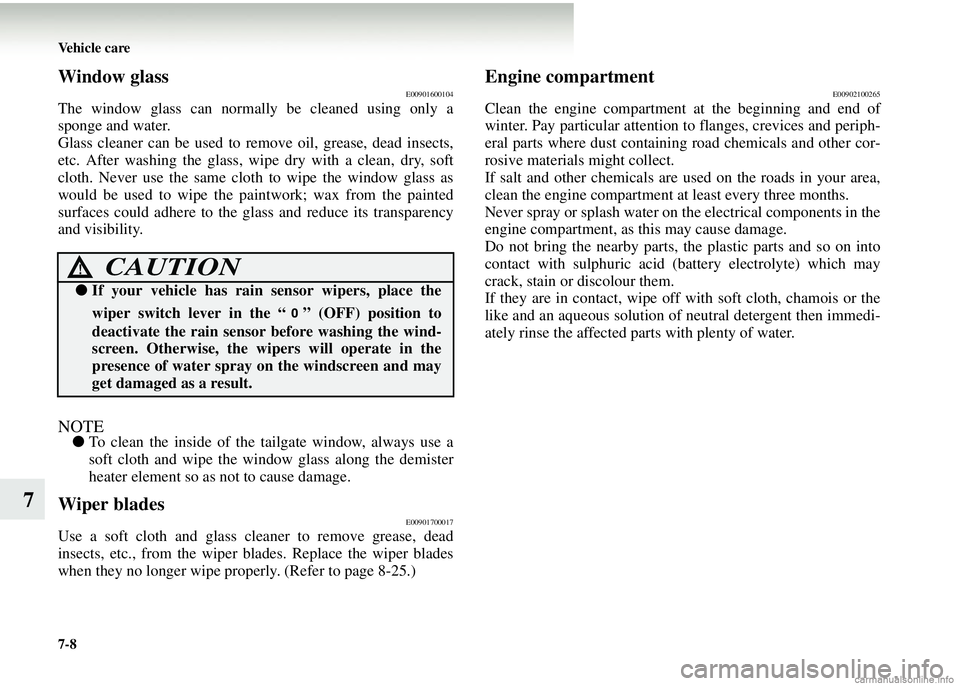
7-8 Vehicle care
7
Window glassE00901600104
The window glass can normally be cleaned using only a
sponge and water.
Glass cleaner can be used to re move oil, grease, dead insects,
etc. After washing the glass, wi pe dry with a clean, dry, soft
cloth. Never use the same cloth to wipe the window glass as
would be used to wipe the paintwork; wax from the painted
surfaces could adhere to the gl ass and reduce its transparency
and visibility.
NOTE● To clean the inside of the tailgate window, always use a
soft cloth and wipe the window glass along the demister
heater element so as not to cause damage.
Wiper bladesE00901700017
Use a soft cloth and glass cleaner to remove grease, dead
insects, etc., from the wiper blades. Replace the wiper blades
when they no longer wipe properly. (Refer to page 8-25.)
Engine compartmentE00902100265
Clean the engine compartment at the beginning and end of
winter. Pay particular attention to flanges, crevices and periph-
eral parts where dust containing road chemicals and other cor-
rosive materials might collect.
If salt and other chemicals ar e used on the roads in your area,
clean the engine compartment at least every three months.
Never spray or splash water on the electrical components in the
engine compartment, as this may cause damage.
Do not bring the nearby parts, the plastic parts and so on into
contact with sulphuric acid (bat tery electrolyte) which may
crack, stain or discolour them.
If they are in contact, wipe off with soft cloth, chamois or the
like and an aqueous solution of neutral detergent then immedi-
ately rinse the affected pa rts with plenty of water.
CAUTION!
●If your vehicle has rain sensor wipers, place the
wiper switch lever in th e “ ” (OFF) position to
deactivate the rain sensor before washing the wind-
screen. Otherwise, the wip ers will operate in the
presence of water spray on the windscreen and may
get damaged as a result.
Page 356 of 450
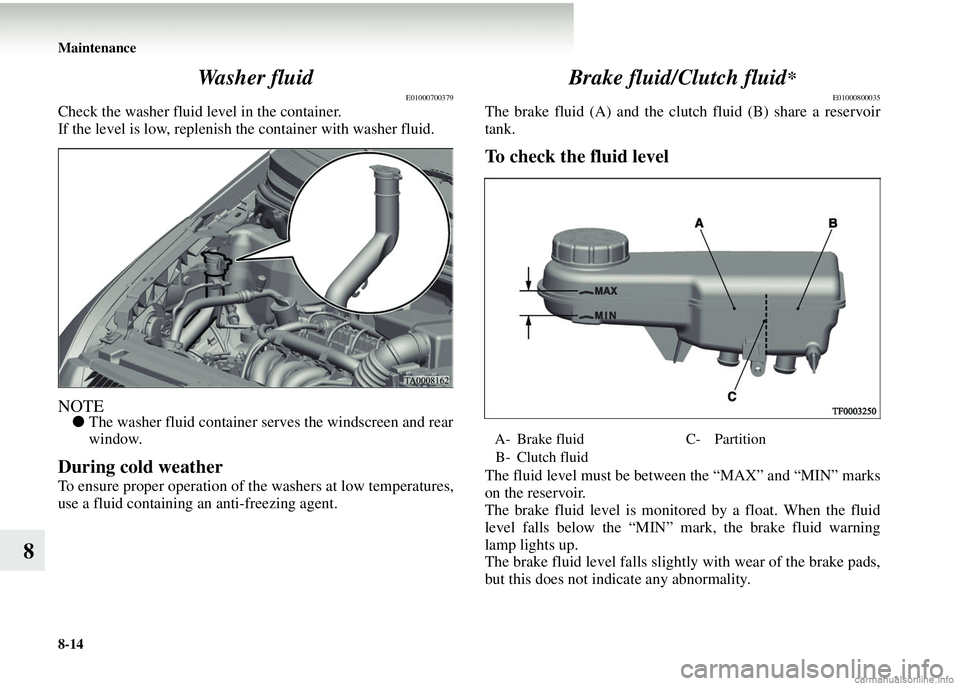
8-14 Maintenance
8Wa s h e r f l u i d
E01000700379
Check the washer fluid level in the container.
If the level is low, replenish the container with washer fluid.
NOTE●
The washer fluid container serves the windscreen and rear
window.
During cold weather
To ensure proper oper ation of the washers at low temperatures,
use a fluid containing an anti-freezing agent.
Brake fluid/Clutch fluid*
E01000800035
The brake fluid (A) and the clutch fluid (B) share a reservoir
tank.
To check the fluid level
The fluid level must be between the “MAX” and “MIN” marks
on the reservoir.
The brake fluid level is monitored by a float. When the fluid
level falls below the “MIN” mark, the brake fluid warning
lamp lights up.
The brake fluid level falls slightly with wear of the brake pads,
but this does not indicate any abnormality.
A- Brake fluid C- Partition
B- Clutch fluid
Page 367 of 450
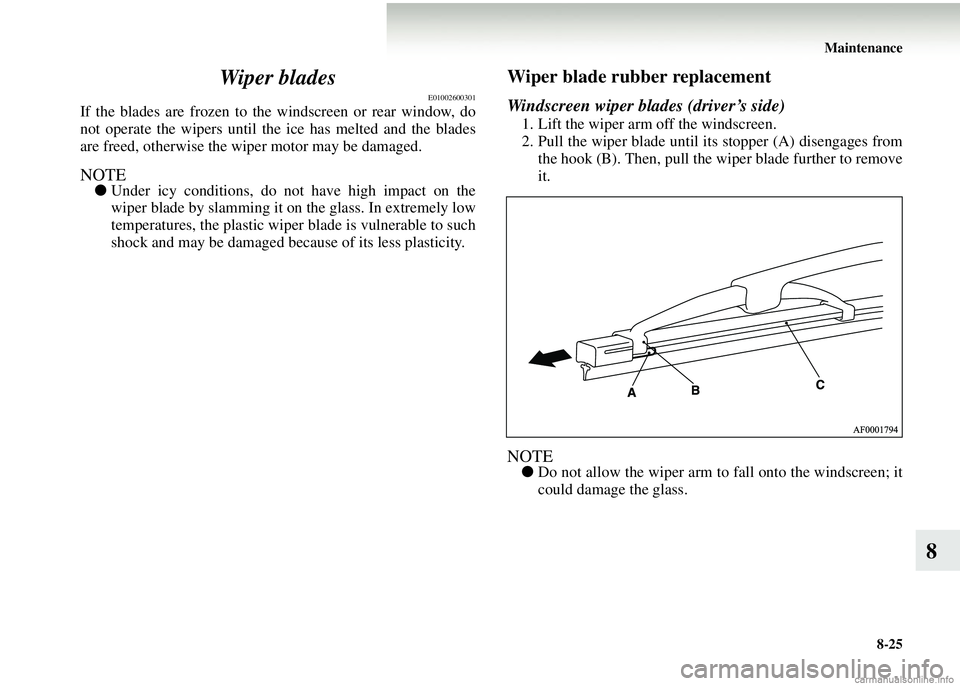
Maintenance8-25
8
Wiper blades
E01002600301
If the blades are frozen to th
e windscreen or rear window, do
not operate the wipers until th e ice has melted and the blades
are freed, otherwise the wiper motor may be damaged.
NOTE● Under icy conditions, do not have high impact on the
wiper blade by slamming it on th e glass. In extremely low
temperatures, the plastic wiper blade is vulnerable to such
shock and may be damaged because of its less plasticity.
Wiper blade rubber replacement
Windscreen wiper blades (driver’s side)
1. Lift the wiper arm off the windscreen.
2. Pull the wiper blade until its stopper (A) disengages from the hook (B). Then, pull the wiper blade further to remove
it.
NOTE● Do not allow the wiper arm to fall onto the windscreen; it
could damage the glass.
Page 370 of 450
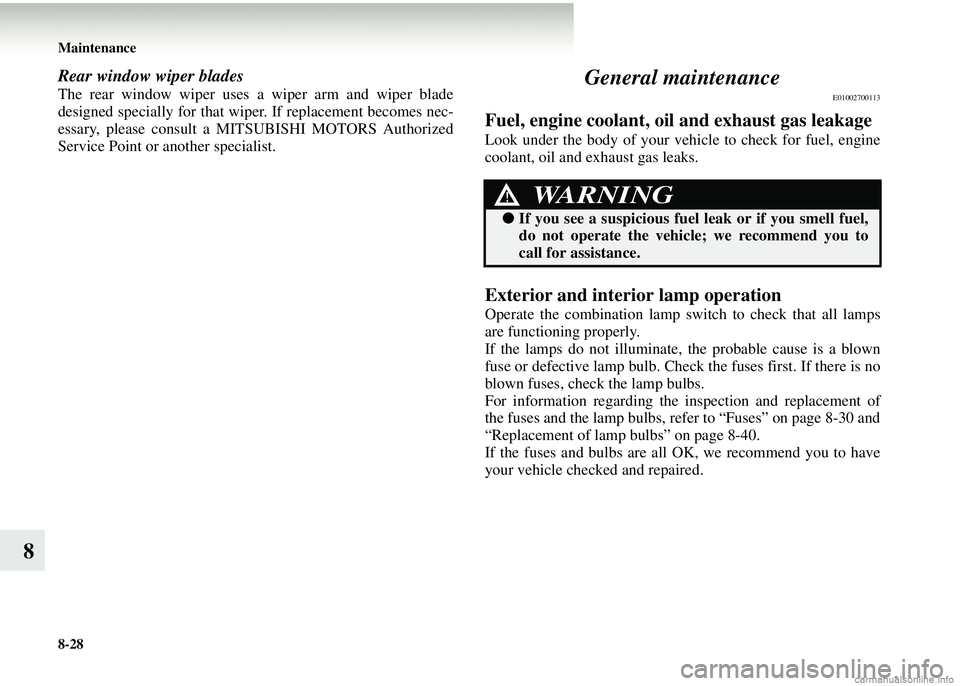
8-28 Maintenance
8
Rear window wiper blades
The rear window wiper uses a wiper arm and wiper blade
designed specially for that wipe r. If replacement becomes nec-
essary, please consult a MITSUBISHI MOTORS Authorized
Service Point or another specialist.General maintenance
E01002700113
Fuel, engine coolant, o il and exhaust gas leakage
Look under the body of your vehicle to check for fuel, engine
coolant, oil and exhaust gas leaks.
Exterior and interior lamp operation
Operate the combination lamp sw itch to check that all lamps
are functioning properly.
If the lamps do not illuminate, the probable cause is a blown
fuse or defective lamp bulb. Check the fuses first. If there is no
blown fuses, check the lamp bulbs.
For information regarding th e inspection and replacement of
the fuses and the lamp bulbs, refer to “Fuses” on page 8-30 and
“Replacement of lamp bu lbs” on page 8-40.
If the fuses and bulbs are all OK, we recommend you to have
your vehicle checked and repaired.
WARNING!
● If you see a suspicious fuel leak or if you smell fuel,
do not operate the vehicle; we recommend you to
call for assistance.
Page 371 of 450

Maintenance8-29
8
Meter, gauge and indicator/warning lamps
operation
Run the engine to check the op eration of all meters, gauges,
and indicator/warning lamps.
If there is anything wrong, we recommend you to have your
vehicle inspected.
Hinges and latches lubrication
Check all latches and hinges, and lubricate if necessary by first
cleaning and then appl ying multipurpose grease.
For cold and snow weather
E01002800172
Ventilation slots
The ventilation slots in front of the windscreen should be
brushed clear after a heavy snowfall so that the operation of the
heating and ventilation systems will not be impaired.
Weatherstripping
To prevent freezing of the weatherstripping on the doors, bon-
net, etc., they should be treated with silicone grease or spray.
Additional equipment
It is a good idea to carry a shovel or a short-handled spade in
the vehicle during the winter so that you can clear away snow
if you get stranded. A small hand-brush for sweeping snow off
the vehicle and a plastic scraper for the windscreen and rear
window are also useful.
Page 375 of 450
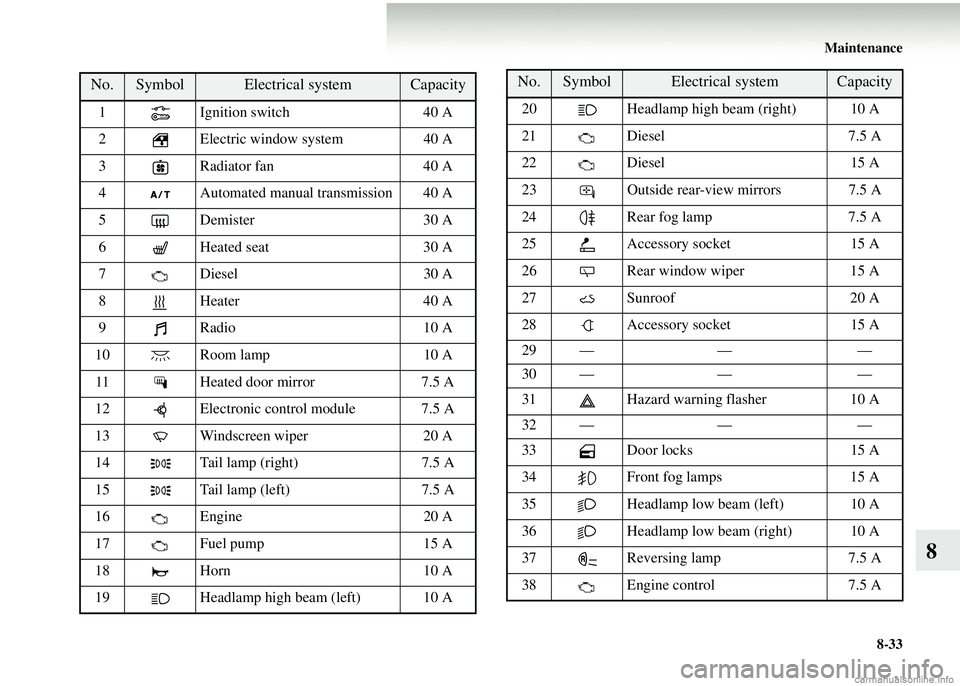
Maintenance8-33
8
No. Symbol Electrical systemCapacity
1 Ignition switch 40 A
2 Electric window system 40 A
3 Radiator fan 40 A
4 Automated manual transmission 40 A
5 Demister 30 A
6 Heated seat 30 A
7 Diesel 30 A
8 Heater 40 A
9 Radio 10 A
10 Room lamp 10 A
11 Heated door mirror 7.5 A
12 Electronic control module 7.5 A
13 Windscreen wiper20 A
14 Tail lamp (right) 7.5 A
15 Tail lamp (left) 7.5 A
16 Engine 20 A
17 Fuel pump 15 A
18 Horn 10 A
19 Headlamp high beam (left) 10 A 20 Headlamp high beam (right) 10 A
21 Diesel 7.5 A
22 Diesel 15 A
23 Outside rear-view mirrors 7.5 A
24 Rear fog lamp 7.5 A
25 Accessory socket 15 A
26 Rear window wiper 15 A
27 Sunroof 20 A
28 Accessory socket 15 A
29 — ——
30 — ——
31 Hazard warning flasher 10 A
32 — ——
33 Door locks 15 A
34 Front fog lamps 15 A
35 Headlamp low beam (left) 10 A
36 Headlamp low beam (right) 10 A
37 Reversing lamp 7.5 A
38 Engine control 7.5 A
No. Symbol Electrical systemCapacity
Page 382 of 450

8-40 Maintenance
8
To replace the cover (RHD vehicles)E01006900025
Align the tab (A) on the cover with the hole, then press the
cover into place.
Replacement of lamp bulbs
E01003100433
Before replacing a bulb, ensure the lamp is off. Do not touch
the glass part of the new bulb with your bare fingers; the skin
oil left on the glass will evapor ate when the bulb gets hot and
the vapour will condense on the reflector and dim the surface.
NOTE● If you are unsure of how to carry out the work as required,
we recommend you to consult a specialist.
● Be careful not to scratch the vehicle body when removing
a lamp and lens.
● When it rains or the vehicle has been washed, the inside of
the lens becomes foggy sometimes. This is the same phe-
nomenon as when window glass mists up on a humid day,
and does not indicate a functional problem. When the
lamp is switched on, the heat will remove the fog. How-
ever, if water gathers inside the lamp, we recommend you
have the lamp checked.
CAUTION!
●Bulbs are extremely hot immediately after being
turned off.
When replacing a bulb, wait for it to cool sufficiently
before touching it. You could otherwise be burnt.
Page 438 of 450
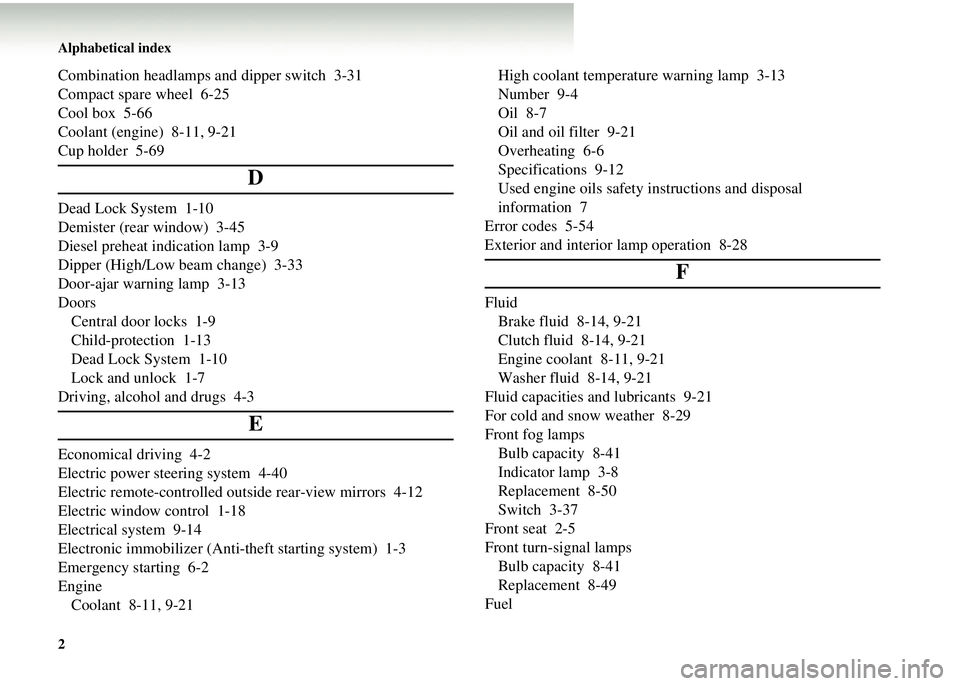
Alphabetical index
2
Combination headlamps and dipper switch 3-31
Compact spare wheel 6-25
Cool box 5-66
Coolant (engine) 8-11, 9-21
Cup holder 5-69
D
Dead Lock System 1-10
Demister (rear window) 3-45
Diesel preheat indication lamp 3-9
Dipper (High/Low beam change) 3-33
Door-ajar warning lamp 3-13
Doors Central door locks 1-9
Child-protection 1-13
Dead Lock System 1-10
Lock and unlock 1-7
Driving, alcohol and drugs 4-3
E
Economical driving 4-2
Electric power steering system 4-40
Electric remote-controlled outside rear-view mirrors 4-12
Electric window control 1-18
Electrical system 9-14
Electronic immobilizer (Anti-theft starting system) 1-3
Emergency starting 6-2
Engine Coolant 8-11, 9-21 High coolant temperat
ure warning lamp 3-13
Number 9-4
Oil 8-7
Oil and oil filter 9-21
Overheating 6-6
Specifications 9-12
Used engine oils safety instructions and disposal
information 7
Error codes 5-54
Exterior and interior lamp operation 8-28
F
Fluid Brake fluid 8-14, 9-21
Clutch fluid 8-14, 9-21
Engine coolant 8-11, 9-21
Washer fluid 8-14, 9-21
Fluid capacities and lubricants 9-21
For cold and snow weather 8-29
Front fog lamps Bulb capacity 8-41
Indicator lamp 3-8
Replacement 8-50
Switch 3-37
Front seat 2-5
Front turn-signal lamps Bulb capacity 8-41
Replacement 8-49
Fuel